铌矿资源及其选矿工艺
- 格式:pdf
- 大小:213.36 KB
- 文档页数:3

铌矿铌矿又被称为钽铌矿,是一种重要的矿石,其中含有铌和钽这两种金属元素。
铌(Nb)是一种银灰色的过渡金属,化学性质稳定,具有良好的耐腐蚀性和导电性能。
在钢铁、航空航天、核能和化工等领域具有广泛的应用。
钽(Ta)是相对稀有的元素,也属于过渡金属,具有极高的熔点和耐腐蚀性,常用于制作高温合金、超导材料和医疗设备等。
铌矿主要分布在世界各地的矿床中,尤其是巴西、加拿大、澳大利亚和刚果等国家。
其中,巴西是全球最大的铌矿生产国,其矿床富集程度高,资源储量丰富。
另外,澳大利亚的铌矿资源也十分丰富,其矿床多样化,既有富铌矿床,也有含钽的铌矿床。
此外,中国、尼日利亚和刚果等国家也有大量的铌矿资源。
铌矿一般以“钶铌矿”的形式存在,其主要矿物有针铌石、绿铌石和胆钽铌矿等。
针铌石是铌矿中含量最高的矿物,针状结构使其具有良好的物理特性,适合用于制备铁合金和陶瓷材料。
绿铌石是钶铌矿中含量居中的一种矿石,其含有铌、钽、铁和锡等元素,可用于制备金属铌和钽金属粉末。
胆钽铌矿是含有钽较多的一种矿石,同时也含有一定量的铌和锡。
这些矿物经过选矿和冶炼处理后,可以得到高纯度的铌和钽金属。
铌矿的提取方法主要包括矿石选矿、焙烧、浸出、萃取和电积等步骤。
首先,在选矿过程中,通过矿石的物理性质差异,分离出高钽铌矿和高铌矿。
然后,将钽铌矿经过焙烧处理,使其中的含钽矿物转化成钽酸盐和钽酸氯。
随后,采用浸出和萃取过程,将钽和铌分离出来。
最后,通过电积的方法,将萃取得到的钽和铌金属还原成纯净的钽和铌。
铌矿的应用领域广泛,其中最重要的应用之一是在钢铁冶金中作为合金元素。
由于铌的加入可以显著提高钢材的强度和韧性,使其在高温和低温条件下都具有良好的力学性能。
此外,铌合金还可以用于制作超导材料和高温合金等,在航空航天领域有着重要的应用。
铌也可以用于制作氧化铌陶瓷材料,具有良好的电介质性能和耐高温性能,有着广泛的应用前景。
总之,铌矿是一种重要的矿石资源,其中含有铌和钽这两种金属元素。
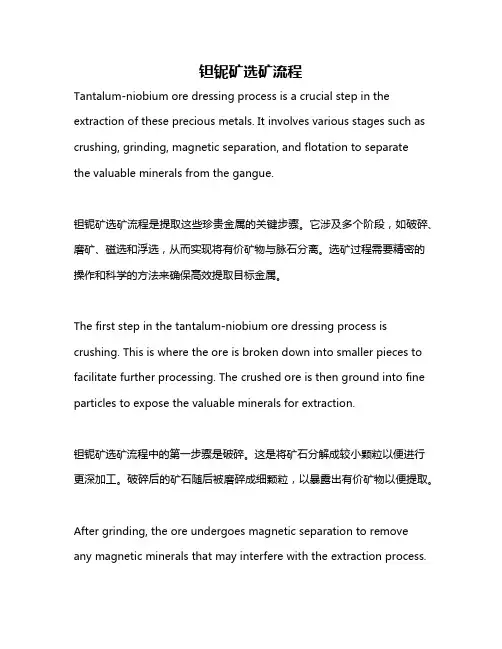
钽铌矿选矿流程Tantalum-niobium ore dressing process is a crucial step in the extraction of these precious metals. It involves various stages such as crushing, grinding, magnetic separation, and flotation to separatethe valuable minerals from the gangue.钽铌矿选矿流程是提取这些珍贵金属的关键步骤。
它涉及多个阶段,如破碎、磨矿、磁选和浮选,从而实现将有价矿物与脉石分离。
选矿过程需要精密的操作和科学的方法来确保高效提取目标金属。
The first step in the tantalum-niobium ore dressing process is crushing. This is where the ore is broken down into smaller pieces to facilitate further processing. The crushed ore is then ground into fine particles to expose the valuable minerals for extraction.钽铌矿选矿流程中的第一步骤是破碎。
这是将矿石分解成较小颗粒以便进行更深加工。
破碎后的矿石随后被磨碎成细颗粒,以暴露出有价矿物以便提取。
After grinding, the ore undergoes magnetic separation to removeany magnetic minerals that may interfere with the extraction process.This is followed by flotation, where froth flotation is used to separate the valuable minerals from the gangue based on their hydrophobicity.磨磨后,矿石经过磁选处理,以去除可能干扰提取过程的任何磁性矿物。

细粒钽铌矿选矿工艺流程英文回答:Tantalum-niobium ore is a valuable mineral resourcethat is widely used in various industries, including electronics, aerospace, and automotive. The ore istypically found in complex geological formations andrequires a detailed beneficiation process to extract the valuable minerals. In this article, I will discuss the process of beneficiation for fine-grained tantalum-niobium ore.The beneficiation process for fine-grained tantalum-niobium ore typically involves several stages, including crushing, grinding, gravity separation, magnetic separation, and flotation. Let's go through each stage in detail.1. Crushing: The first step in the beneficiationprocess is to crush the ore into small particles. This can be done using jaw crushers or cone crushers. The crushedore is then further ground to a finer size using ball mills or rod mills.2. Grinding: The ground ore is then subjected togrinding to further reduce its size. This is typically done using ball mills or rod mills. The purpose of grinding isto liberate the valuable minerals from the gangue minerals and prepare the ore for the subsequent separation processes.3. Gravity separation: After grinding, the ore is subjected to gravity separation to separate the heavy minerals from the light minerals. Gravity separation is based on the differences in the specific gravity of the minerals. Common gravity separation methods include jigging, shaking table, and spiral chute. The heavy minerals, suchas tantalum and niobium, will settle to the bottom, whilethe light minerals will float to the top.4. Magnetic separation: The next step is magnetic separation, which is used to separate the magnetic minerals from the non-magnetic minerals. This is achieved byapplying a magnetic field to the ore. The magnetic minerals,such as magnetite and ilmenite, will be attracted to the magnetic field and can be easily separated from the non-magnetic minerals.5. Flotation: The final stage in the beneficiation process is flotation, which is used to separate the valuable minerals from the gangue minerals based on their hydrophobicity. In flotation, the ore is mixed with water and chemicals, and air bubbles are introduced. The hydrophobic minerals will attach to the air bubbles andrise to the surface, forming a froth, while the hydrophilic gangue minerals will remain in the water. The froth containing the valuable minerals can then be collected and further processed.Overall, the beneficiation process for fine-grained tantalum-niobium ore involves crushing, grinding, gravity separation, magnetic separation, and flotation. Each stage plays a crucial role in extracting the valuable minerals and preparing the ore for further processing. By optimizing each stage of the process, it is possible to achieve a high recovery rate of tantalum and niobium from the ore.中文回答:钽铌矿是一种有价值的矿产资源,广泛应用于电子、航空航天和汽车等各个行业。
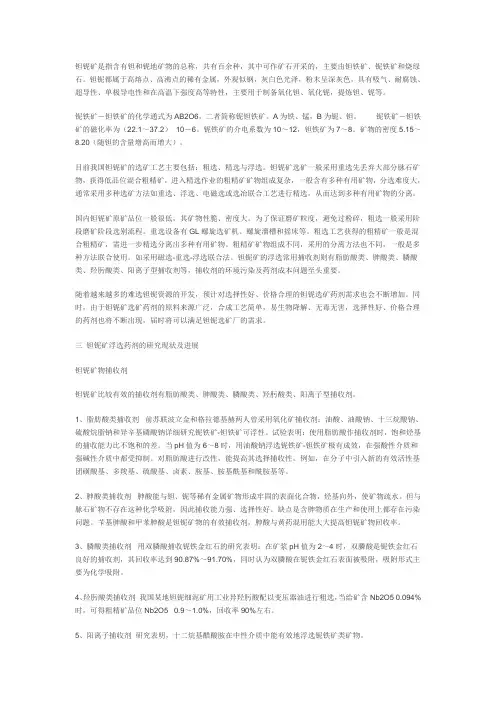
钽铌矿是指含有钽和铌地矿物的总称,共有百余种,其中可作矿石开采的,主要由钽铁矿、铌铁矿和烧绿石。
钽铌都属于高熔点、高沸点的稀有金属,外观似钢,灰白色光泽,粉末呈深灰色,具有吸气、耐腐蚀、超导性、单极导电性和在高温下强度高等特性,主要用于制备氧化钽、氧化铌,提炼钽、铌等。
铌铁矿-钽铁矿的化学通式为AB2O6,二者简称铌钽铁矿。
A为铁、锰,B为铌、钽。
铌铁矿-钽铁矿的磁化率为(22.1~37.2)×10-6。
铌铁矿的介电系数为10~12,钽铁矿为7~8。
矿物的密度5.15~8.20(随钽的含量增高而增大)。
目前我国钽铌矿的选矿工艺主要包括:粗选、精选与浮选。
钽铌矿选矿一般采用重选先丢弃大部分脉石矿物,获得低品位混合粗精矿,进入精选作业的粗精矿矿物组成复杂,一般含有多种有用矿物,分选难度大,通常采用多种选矿方法如重选、浮选、电磁选或选冶联合工艺进行精选,从而达到多种有用矿物的分离。
国内钽铌矿原矿品位一般很低,其矿物性脆、密度大。
为了保证磨矿粒度,避免过粉碎,粗选一般采用阶段磨矿阶段选别流程。
重选设备有GL螺旋选矿机、螺旋溜槽和摇床等。
粗选工艺获得的粗精矿一般是混合粗精矿,需进一步精选分离出多种有用矿物。
粗精矿矿物组成不同,采用的分离方法也不同,一般是多种方法联合使用。
如采用磁选-重选-浮选联合法。
钽铌矿的浮选常用捕收剂则有脂肪酸类、胂酸类、膦酸类、羟肟酸类、阳离子型捕收剂等,捕收剂的环境污染及药剂成本问题至头重要。
随着越来越多的难选钽铌资源的开发,预计对选择性好、价格合理的钽铌选矿药剂需求也会不断增加。
同时,由于钽铌矿选矿药剂的原料来源广泛,合成工艺简单,易生物降解、无毒无害,选择性好、价格合理的药剂也将不断出现,届时将可以满足钽铌选矿厂的需求。
三钽铌矿浮选药剂的研究现状及进展钽铌矿物捕收剂钽铌矿比较有效的捕收剂有脂肪酸类、胂酸类、膦酸类、羟肟酸类、阳离子型捕收剂。
1、脂肪酸类捕收剂前苏联波立金和格拉德基赫两人曾采用氧化矿捕收剂:油酸、油酸钠、十三烷酸钠、硫酸烷脂钠和异辛基磷酸钠详细研究铌铁矿-钽铁矿可浮性。
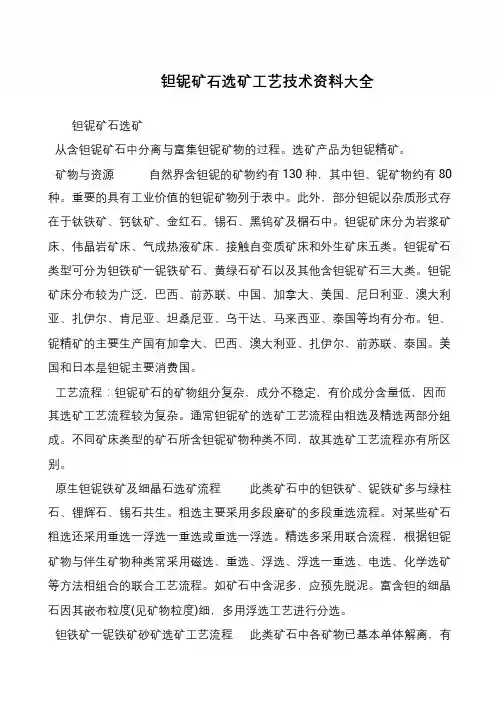
世上无难事,只要肯攀登钽铌矿石选矿工艺技术资料大全钽铌矿石选矿从含钽铌矿石中分离与富集钽铌矿物的过程。
选矿产品为钽铌精矿。
矿物与资源自然界含钽铌的矿物约有130 种,其中钽、铌矿物约有80 种。
重要的具有工业价值的钽铌矿物列于表中。
此外,部分钽铌以杂质形式存在于钛铁矿、钙钛矿、金红石、锡石、黑钨矿及榍石中。
钽铌矿床分为岩浆矿床、伟晶岩矿床、气成热液矿床、接触自变质矿床和外生矿床五类。
钽铌矿石类型可分为钽铁矿一铌铁矿石、黄绿石矿石以及其他含钽铌矿石三大类。
钽铌矿床分布较为广泛,巴西、前苏联、中国、加拿大、美国、尼日利亚、澳大利亚、扎伊尔、肯尼亚、坦桑尼亚、乌干达、马来西亚、泰国等均有分布。
钽、铌精矿的主要生产国有加拿大、巴西、澳大利亚、扎伊尔、前苏联、泰国。
美国和日本是钽铌主要消费国。
工艺流程:钽铌矿石的矿物组分复杂,成分不稳定,有价成分含量低,因而其选矿工艺流程较为复杂。
通常钽铌矿的选矿工艺流程由粗选及精选两部分组成。
不同矿床类型的矿石所含钽铌矿物种类不同,故其选矿工艺流程亦有所区别。
原生钽铌铁矿及细晶石选矿流程此类矿石中的钽铁矿、铌铁矿多与绿柱石、锂辉石、锡石共生。
粗选主要采用多段磨矿的多段重选流程。
对某些矿石粗选还采用重选一浮选一重选或重选一浮选。
精选多采用联合流程,根据钽铌矿物与伴生矿物种类常采用磁选、重选、浮选、浮选一重选、电选、化学选矿等方法相组合的联合工艺流程。
如矿石中含泥多,应预先脱泥。
富含钽的细晶石因其嵌布粒度(见矿物粒度)细,多用浮选工艺进行分选。
钽铁矿一铌铁矿砂矿选矿工艺流程此类矿石中各矿物已基本单体解离,有。
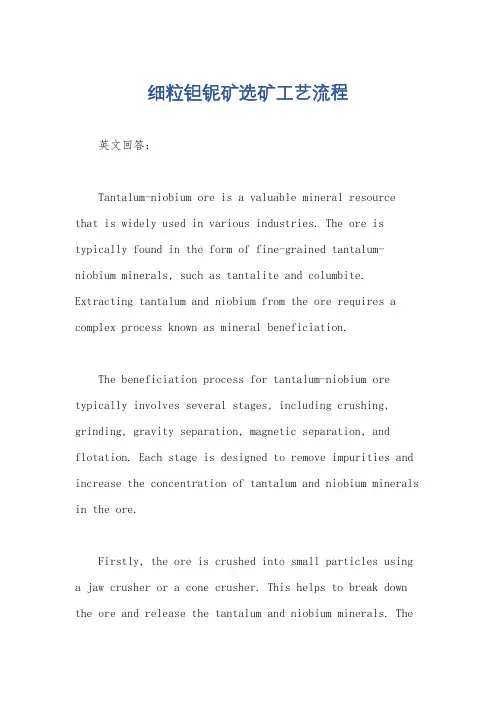
细粒钽铌矿选矿工艺流程英文回答:Tantalum-niobium ore is a valuable mineral resourcethat is widely used in various industries. The ore is typically found in the form of fine-grained tantalum-niobium minerals, such as tantalite and columbite. Extracting tantalum and niobium from the ore requires a complex process known as mineral beneficiation.The beneficiation process for tantalum-niobium ore typically involves several stages, including crushing, grinding, gravity separation, magnetic separation, and flotation. Each stage is designed to remove impurities and increase the concentration of tantalum and niobium minerals in the ore.Firstly, the ore is crushed into small particles using a jaw crusher or a cone crusher. This helps to break down the ore and release the tantalum and niobium minerals. Thecrushed ore is then ground into a fine powder using a ball mill or a rod mill. This grinding process helps to further liberate the minerals and increase their surface area for subsequent separation.Next, gravity separation is employed to separate the heavier tantalum and niobium minerals from the lighter gangue minerals. This is done using techniques such as spiral concentrators, shaking tables, or centrifugal concentrators. The principle behind gravity separation is that the denser minerals will settle to the bottom, while the lighter minerals will rise to the top. By adjusting the parameters of the gravity separation equipment, such as the angle of inclination or the water flow rate, the desired separation can be achieved.After gravity separation, magnetic separation is used to remove any remaining magnetic minerals from thetantalum-niobium concentrate. This is done using high-intensity magnetic separators, which generate a strong magnetic field to attract and separate the magnetic minerals. The non-magnetic minerals are discarded as waste,while the magnetic minerals are collected as a magnetic concentrate.Finally, flotation is employed to further increase the concentration of tantalum and niobium minerals in the concentrate. Flotation involves the use of chemicals, such as collectors and frothers, to selectively separate the valuable minerals from the gangue minerals. The froth flotation process relies on the differences in the surface properties of the minerals, allowing the valuable minerals to attach to air bubbles and float to the surface, while the gangue minerals sink.Overall, the beneficiation process for tantalum-niobium ore is a complex and multi-stage process. It requires careful optimization and control to achieve the desired separation and concentration of tantalum and niobium minerals. However, with the right combination of equipment and process parameters, it is possible to produce a high-quality tantalum-niobium concentrate that can be further processed into valuable products.中文回答:英文回答:钽铌矿是一种有价值的矿产资源,广泛应用于各个行业。
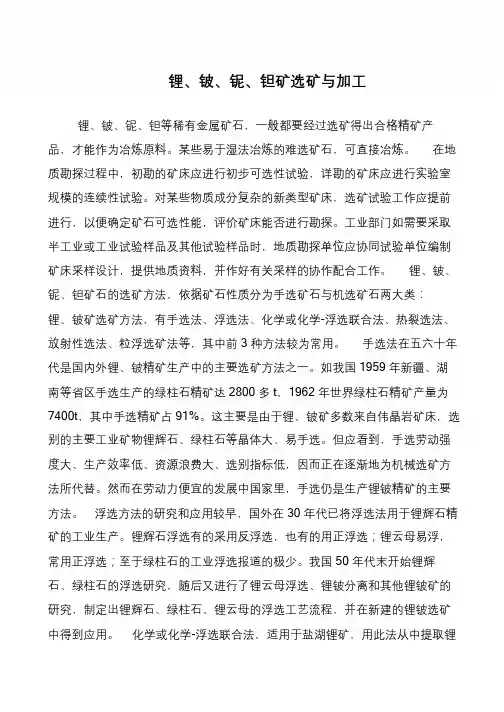
书山有路勤为径,学海无涯苦作舟锂、铍、铌、钽矿选矿与加工锂、铍、铌、钽等稀有金属矿石,一般都要经过选矿得出合格精矿产品,才能作为冶炼原料。
某些易于湿法冶炼的难选矿石,可直接冶炼。
在地质勘探过程中,初勘的矿床应进行初步可选性试验,详勘的矿床应进行实验室规模的连续性试验。
对某些物质成分复杂的新类型矿床,选矿试验工作应提前进行,以便确定矿石可选性能,评价矿床能否进行勘探。
工业部门如需要采取半工业或工业试验样品及其他试验样品时,地质勘探单位应协同试验单位编制矿床采样设计,提供地质资料,并作好有关采样的协作配合工作。
锂、铍、铌、钽矿石的选矿方法,依据矿石性质分为手选矿石与机选矿石两大类:锂、铍矿选矿方法,有手选法、浮选法、化学或化学-浮选联合法、热裂选法、放射性选法、粒浮选矿法等,其中前3 种方法较为常用。
手选法在五六十年代是国内外锂、铍精矿生产中的主要选矿方法之一。
如我国1959 年新疆、湖南等省区手选生产的绿柱石精矿达2800 多t,1962 年世界绿柱石精矿产量为7400t,其中手选精矿占91%。
这主要是由于锂、铍矿多数来自伟晶岩矿床,选别的主要工业矿物锂辉石、绿柱石等晶体大、易手选。
但应看到,手选劳动强度大、生产效率低、资源浪费大、选别指标低,因而正在逐渐地为机械选矿方法所代替。
然而在劳动力便宜的发展中国家里,手选仍是生产锂铍精矿的主要方法。
浮选方法的研究和应用较早,国外在30 年代已将浮选法用于锂辉石精矿的工业生产。
锂辉石浮选有的采用反浮选,也有的用正浮选;锂云母易浮,常用正浮选;至于绿柱石的工业浮选报道的极少。
我国50 年代末开始锂辉石、绿柱石的浮选研究,随后又进行了锂云母浮选、锂铍分离和其他锂铍矿的研究,制定出锂辉石、绿柱石、锂云母的浮选工艺流程,并在新建的锂铍选矿中得到应用。
化学或化学-浮选联合法,适用于盐湖锂矿,用此法从中提取锂。
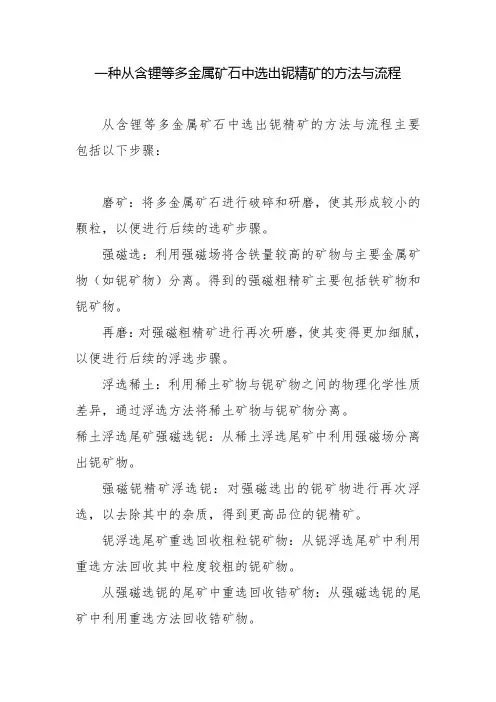
一种从含锂等多金属矿石中选出铌精矿的方法与流程
从含锂等多金属矿石中选出铌精矿的方法与流程主要包括以下步骤:
磨矿:将多金属矿石进行破碎和研磨,使其形成较小的颗粒,以便进行后续的选矿步骤。
强磁选:利用强磁场将含铁量较高的矿物与主要金属矿物(如铌矿物)分离。
得到的强磁粗精矿主要包括铁矿物和铌矿物。
再磨:对强磁粗精矿进行再次研磨,使其变得更加细腻,以便进行后续的浮选步骤。
浮选稀土:利用稀土矿物与铌矿物之间的物理化学性质差异,通过浮选方法将稀土矿物与铌矿物分离。
稀土浮选尾矿强磁选铌:从稀土浮选尾矿中利用强磁场分离出铌矿物。
强磁铌精矿浮选铌:对强磁选出的铌矿物进行再次浮选,以去除其中的杂质,得到更高品位的铌精矿。
铌浮选尾矿重选回收粗粒铌矿物:从铌浮选尾矿中利用重选方法回收其中粒度较粗的铌矿物。
从强磁选铌的尾矿中重选回收锆矿物:从强磁选铌的尾矿中利用重选方法回收锆矿物。
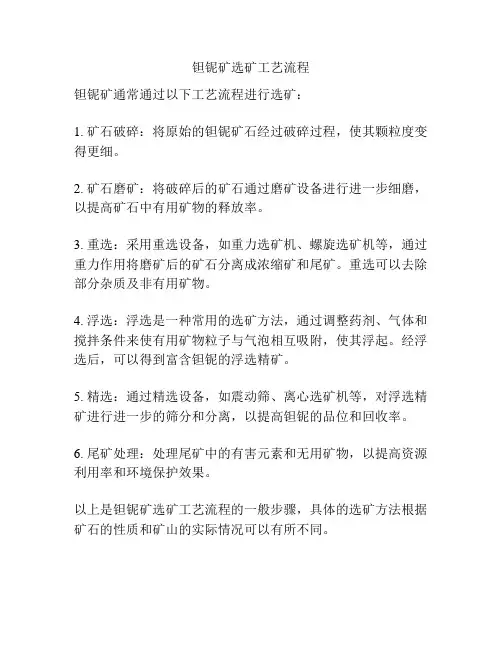
钽铌矿选矿工艺流程
钽铌矿通常通过以下工艺流程进行选矿:
1. 矿石破碎:将原始的钽铌矿石经过破碎过程,使其颗粒度变得更细。
2. 矿石磨矿:将破碎后的矿石通过磨矿设备进行进一步细磨,以提高矿石中有用矿物的释放率。
3. 重选:采用重选设备,如重力选矿机、螺旋选矿机等,通过重力作用将磨矿后的矿石分离成浓缩矿和尾矿。
重选可以去除部分杂质及非有用矿物。
4. 浮选:浮选是一种常用的选矿方法,通过调整药剂、气体和搅拌条件来使有用矿物粒子与气泡相互吸附,使其浮起。
经浮选后,可以得到富含钽铌的浮选精矿。
5. 精选:通过精选设备,如震动筛、离心选矿机等,对浮选精矿进行进一步的筛分和分离,以提高钽铌的品位和回收率。
6. 尾矿处理:处理尾矿中的有害元素和无用矿物,以提高资源利用率和环境保护效果。
以上是钽铌矿选矿工艺流程的一般步骤,具体的选矿方法根据矿石的性质和矿山的实际情况可以有所不同。
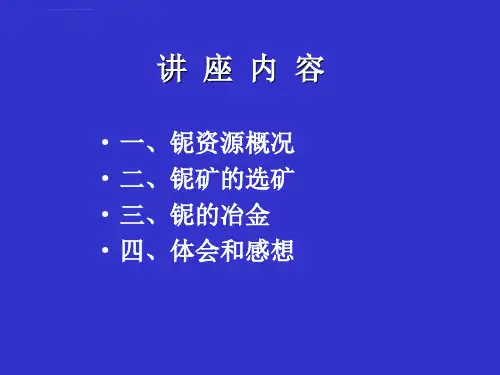

基性岩铌矿选矿工艺流程及注意事项详解下载温馨提示:该文档是我店铺精心编制而成,希望大家下载以后,能够帮助大家解决实际的问题。
文档下载后可定制随意修改,请根据实际需要进行相应的调整和使用,谢谢!并且,本店铺为大家提供各种各样类型的实用资料,如教育随笔、日记赏析、句子摘抄、古诗大全、经典美文、话题作文、工作总结、词语解析、文案摘录、其他资料等等,如想了解不同资料格式和写法,敬请关注!Download tips: This document is carefully compiled by theeditor. I hope that after you download them,they can help yousolve practical problems. The document can be customized andmodified after downloading,please adjust and use it according toactual needs, thank you!In addition, our shop provides you with various types ofpractical materials,such as educational essays, diaryappreciation,sentence excerpts,ancient poems,classic articles,topic composition,work summary,word parsing,copy excerpts,other materials and so on,want to know different data formats andwriting methods,please pay attention!基性岩铌矿选矿工艺流程详解:1. 矿石准备在选矿工艺开始之前,首先需要对矿石进行准备。
金属矿山METAL MINE总第536期2021年第2期Series No.536February2021铌矿资源概述及选矿技术研究进展黎洁3谢贤3吕晋芳3康博文3李博琦3朱辉3(1.昆明理工大学国土资源工程学院,云南昆明650093;2.省部共建复杂有色金属资源清洁利用国家重点实验室,云南昆明650093;3.云南省金属矿尾矿资源二次利用工程研究中心,云南昆明650093)摘要分析了铌的性质、用途、资源现状、分布特征以及矿床类型,归纳总结了国内外铌矿的选矿工艺,并对铌矿浮选药剂及其作用机理进行了阐述。
铌资源主要分布在巴西和加拿大,其中巴西铌储量占总储量80%o铌矿床成因复杂、类型种类较多,可开采和具有开采潜力的铌矿多与碳酸岩有关。
国外铌矿主要是烧绿石,品位较高,选别工艺简单;国内铌矿成分复杂、嵌布粒度细,分选难度大,多采用联合工艺流程综合回收铌矿和伴生矿物,实现资源最大化利用。
目前,大多数浮选研究是采用常规药剂改变铌矿物与脉石矿物之间的可浮性差异,效果不理想,应加强药剂改性、组合用药以及药剂与铌矿的作用机理方面的研究。
关键词铌矿选矿工艺药剂机理中图分类号TD923文献标志码A文章编号1001-1250(2021)-02-120-07DOI10.19614/ki.jsks.202102019Overview of Niobium Resources and Research Progress in Mineral Processing Technology LI Jie1'2'3XIE Xian1'2'3LU Jinfang1'2'3KANG Bowen1'2'3LI Boqi1'2'3ZHU Hui1'2'3(1.Faculty of L and Resource Engineering,Kunming University of S cience and Technology,Kunming650093,China;2.StateKey Laboratory of Complex Nonferrous Metal Resources Clean Utilization,Kunming650093,China;3.Yunnan Province Engineering Research Center f or Reutilization of Metal Tailings Resources,Kunming650093,China) Abstract The properties and application of niobium as well as the status distribution characteristics and type of deposits of niobium ore resources at home and abroad were introduced.The beneficiation technology of niobium ore at home and abroad is summarized and the collector and action mechanism of niobium ore flotation are explained.Niobium resources are mainly distributed in Brazil and Canada,of which Brazil's niobium reserves account for80%of the total reserves.There are many types and complex genesis of niobium deposits minable and potential niobium ore is mostly related to carbonate rock.Foreign niobium ore is mainly pyrochlore with high grade and simple sorting process;domestic niobium ore has complex composition fine embedding size large sorting difficulty the combined process is often used to comprehensively recover niobium ore and associated minerals to maximize resource utilization.At present most of the flotation research is to use conventional agents to change the floatability difference between niobium minerals and gangue minerals the effect is not ideal should strengthen the agent modification combined use of drugs and the mechanism of action of the agent and niobium ore.Keywords niobium,beneficiation process,reagents?mechanism1801年,英国的哈契特在考察不列颠博物馆矿石时,发现了铌元素。
我国钽铌资源的特征及选矿技术程征;伍喜庆;杨平伟【摘要】介绍了我国钽铌资源单一矿床少、共伴生矿床多、矿石品位低、钽铌矿物与其他矿物密切共生、钽铌矿床区域分布高度集中等突出特点.根据钽铌矿物与其他矿物密度的差异,以及钽铌矿物嵌布粒度的粗细等特点,归纳总结了钽铌矿物的回收工艺:对仅钽铌矿物密度大,且钽铌矿物嵌布粒度较粗的矿石,通常采用以重选为主的分选工艺;对有多种矿物密度大,且钽铌矿物嵌布粒度较粗的矿石,多采用重选与磁选、电选等相结合的分选工艺;对有多种矿物密度大,且钽铌矿物嵌布粒度较细的矿石,多采用以浮选为主的分选工艺.%The paper introduces such prominent features of Chinese tantalum and niobium resources as less singular deposits,more associated deposits,low ore grade,closely associated with other minerals,highly concentrated regional distribution of tantalum and niobium deposits and so on.According to the difference of the density between tantalum and niobium minerals and other minerals as well as the dissemination size of ores,the recovery process of tantalum and niobium minerals are summarized.For ores with high density in tantalum and niobium minerals and a coarse-grained dissemination level,the gravity separation as the main way is generally accepted.For ores with high density in various minerals and a coarse-grained dissemination level of tantalum and niobium minerals,a joint process of gravityseparation,magnetic separation and electric separation is mostly adopted.For ores with high density in various minerals and finedissemination of tantalum and niobium minerals,the flotation process is given the priority.【期刊名称】《金属矿山》【年(卷),期】2013(000)007【总页数】4页(P97-100)【关键词】钽铌矿;重选;磁选;浮选【作者】程征;伍喜庆;杨平伟【作者单位】中南大学资源加工与生物工程学院;中南大学资源加工与生物工程学院;中南大学资源加工与生物工程学院【正文语种】中文钽与铌性质相似,均属高熔点、高沸点(钽的熔点为2 996℃、沸点为5 425℃,铌的熔点为2 468℃,沸点为4 742℃)稀有金属,钢灰色泽,延展性和导热性好,抗腐蚀性强。
[整理版]钳锯矿选矿技巧钮規矿选矿技术我们多年来长期从事袒規矿选矿技术研究工作,积累了丰富的经验,获部、省级多项科研成果奖。
LI前,已形成工业矿物学、选矿技术研究的先进系统技术。
具有可承担试验研究、技术服务及咨询的雄用技术实力。
愿竭诚为客户提供服务。
袒锭矿选矿粗选一般采用重选法,精选则采用重选、浮选、电磁选或选冶联合工艺,处理粉矿或原生泥含量多的矿石,洗矿作业必不可少,同时采用高效磨矿分级设备,以降低辺規矿物的泥化。
袒規浮选常用捕收剂有脂肪酸类、肿酸类、麟酸类、羟胯酸类、阳离子型捕收剂等,捕收剂的环境污染及药剂成本问题至头重要。
随着化学工业的发展,原料来源广泛,合成工艺简单,易生物降解、选择性好、无毒无害、价格合理的药剂将不断岀现,满足辺規选矿厂的需求。
1、钮規矿矿物工艺学特性規铁矿,袒铁矿的化学通式为AB206,二者简称規钮铁矿。
A为铁、猛,B为規、从纯铤到袒的不同形式具有一系列同晶结构,其特点是铁和镭的比例不定。
其中含Nb2O5 1.97~7& 88%, Ta205 5. 56~83. 57%, MnO 1. 26~16.25%, FeO 1. 89^16. 25%o还有Ti、Zr、W、TR、U等类质同象混入物。
组元中锭占多数,就称该矿物为锭铁矿,如果钮占多数,则称为钮铁矿。
矿物的晶格为斜方结构,空间群记号为Peano结构山A和B八面体的层所组成。
相同的八面体在层中以边连接成链,再同共同顶点相连。
一个A八面体层通过顶点与邻连的B八面体层从两方面相连,形成BAB结构。
規铁矿,袒铁矿许多矿物的晶格参数与试样的成分有关,其波动范围如T:a=0. 5133和.5054^^=1.445"!. 405nm;c=0. 5762~0. 5683nm。
锯锂猛矿中原子间距:Mn,0二2. 12〜2. 14埃,Ta, 0=1. 86^2. 12埃。
矿物的颜色有黑色、棕黑色和红褐色。
莫氏硬度为:規铁矿4. 3〜6. 5;钮铁矿6.5、7.2。
中国的铌矿床中国是世界上最大的铌资源拥有国之一,其铌矿床分布广泛、储量丰富。
铌是一种重要的稀有金属,广泛应用于钢铁、电子、化工、航空航天等领域。
本文将围绕中国的铌矿床展开介绍,探讨其储量分布、开采现状以及未来的发展前景。
一、铌矿床的储量分布中国的铌矿床主要分布在江西、福建、云南、广东、湖南等地。
其中,江西省是中国铌资源最为丰富的地区之一,拥有丰富的铌矿床储量。
福建省的铌矿床也属于重要的储量区域,其产量和质量在全国乃至全球都有较高的影响力。
云南、广东、湖南等地也分布着大量的铌矿床,为中国的铌产业发展提供了良好的资源基础。
二、铌矿床的开采现状中国的铌矿床主要以钨矿中的伴生铌矿形式存在,因此铌的开采常常与钨矿的开采同时进行。
铌矿的开采主要是通过矿山露天开采和地下开采两种方式进行。
矿山露天开采是指将地表上的铌矿石进行爆破、挖掘和提取的方式,适用于矿床埋藏浅、矿石品位较高的情况。
地下开采则是指通过井巷和坑道进入地下,进行铌矿石的开采和提取。
目前,中国的铌矿开采技术相对成熟,但在资源利用率和环境保护方面仍有进一步提升的空间。
三、铌矿床的发展前景随着经济的快速发展和高新技术的不断涌现,对铌的需求量逐年增加。
铌在钢铁冶炼、电子器件制造、航天航空等领域具有不可替代的重要作用,因此铌产业的发展前景广阔。
中国作为全球最大的铌资源拥有国之一,具有良好的发展优势。
未来,中国的铌矿产业可以通过技术创新、产业升级等方式,提高资源利用率,降低环境污染,实现可持续发展。
同时,还可以加强国际合作,拓宽市场销售渠道,提高产品附加值,提升行业竞争力。
中国的铌矿床分布广泛、储量丰富,具有巨大的开发潜力和发展前景。
通过科学合理的开采和利用,中国的铌矿产业可以为国家经济发展做出重要贡献,并在国际市场上占据一定的地位。
同时,应加强环境保护和资源可持续利用,推动铌产业向高质量发展的方向迈进。
相信在政府和企业的共同努力下,中国的铌矿产业将迎来更加美好的未来。
某铌钇矿石中含铌矿物的工艺矿物学特征及其对选矿的影响1. 引言介绍铌的重要性,介绍铌钇矿石,以及本文的目的和意义。
2. 铌钇矿石中含铌矿物的类型及其特征介绍铌钇矿石中常见的铌矿物,如钽铌矿、铌铁矿等。
分析其物理、化学特征以及结晶形态等方面的特征。
3. 铌钇矿石选矿工艺及其影响因素介绍铌钇矿石的选矿工艺,分析影响铌钇矿石选矿的因素,如矿物结晶、矿物粒度和矿物浮选性等。
探讨这些因素对选矿过程和选矿效果的影响。
4. 铌钇矿石选矿实践及成果介绍铌钇矿石选矿实践,包括选矿的流程和方法,探讨这些方法对铌钇矿石选矿的效果。
介绍铌钇矿石在工业上的应用情况。
5. 结论总结文章的主要内容,强调铌钇矿石选矿的重要性和前景,提出未来研究的方向和建议。
引言铌是一种重要的稀有金属,在现代工业和科技领域有着广泛的应用。
铌钇矿石是铌、钇等元素的主要矿石,其中含铌矿物的种类繁多,如钽铌矿、铌铁矿等。
合理开发铌钇矿石是提高铌、钇等元素资源利用率的重要途径。
在铌钇矿石中,含铌矿物是选矿和提取铌、钇等元素的关键。
因此,分析铌钇矿石中含铌矿物的特征和性质,探讨其对选矿过程和效果的影响,对于改进铌钇矿石开采和提取铌、钇等元素的工艺流程、提高开采效率和利用价值具有重要意义。
本文将从铌钇矿石中含铌矿物的类型及其特征、选矿工艺及其影响因素、铌钇矿石选矿实践及成果等方面进行探讨,旨在为铌钇矿石的开采、提取铌、钇等元素的工艺流程优化提供参考。
铌是一种稀有的过渡金属元素,具有高熔点、高硬度、抗腐蚀、良好的化学稳定性等特点。
铌广泛应用于制造高温合金、超导材料、核反应堆构件、钢铁冶炼、化工等领域。
铌的特殊性能决定了它的供需关系特别紧张,在近年来,铌的价格一直处于高位。
铌钇矿石是铌、钇等元素的主要矿石,分布广泛,主要分布在澳大利亚、加拿大、南非、巴西等地。
在铌钇矿石中,包含了多种含铌矿物,其中常见的有钽铌矿、铌铁矿、铌钽银矿、锰铌矿等。
这些含铌矿物在铌钇矿石中的分布状况、矿物特征等都对该矿石的选矿和提取铌、钇等元素的工艺流程有着重要的影响。